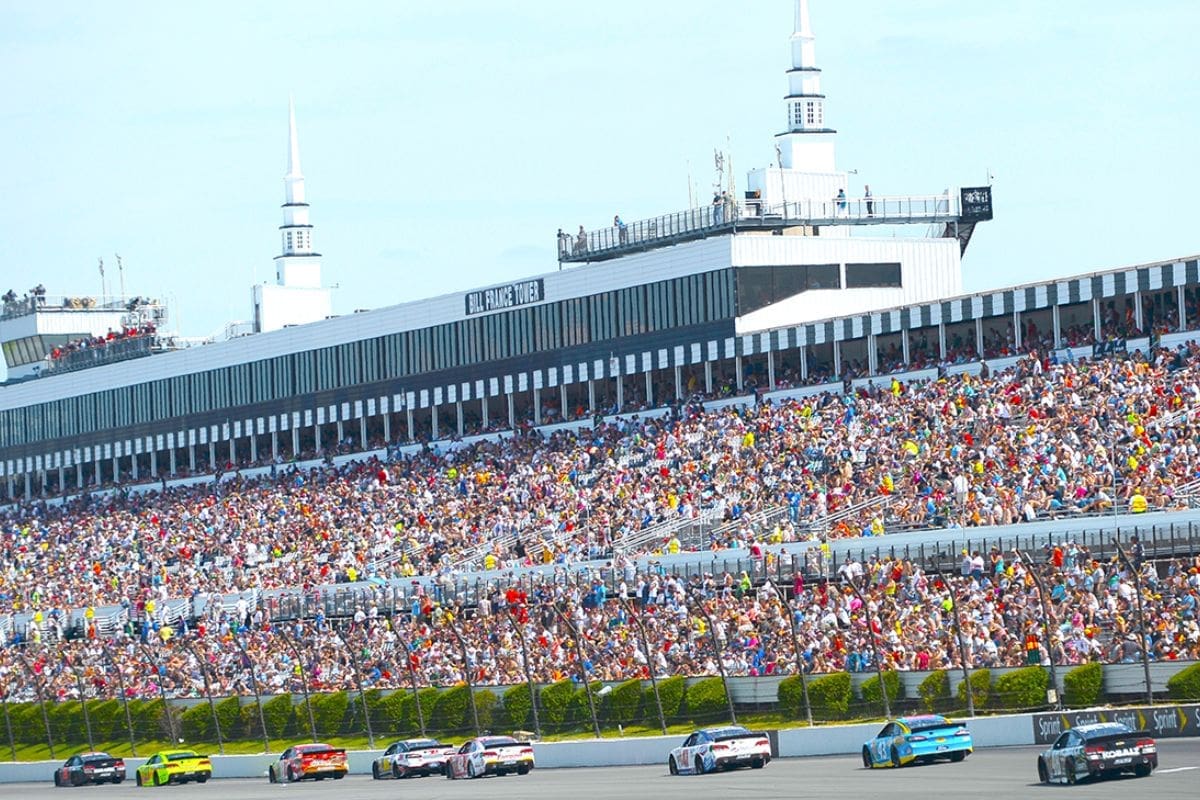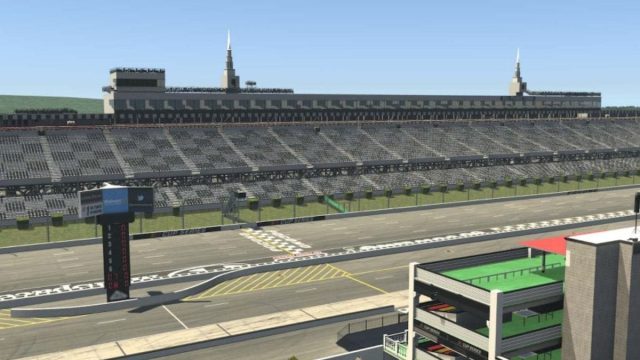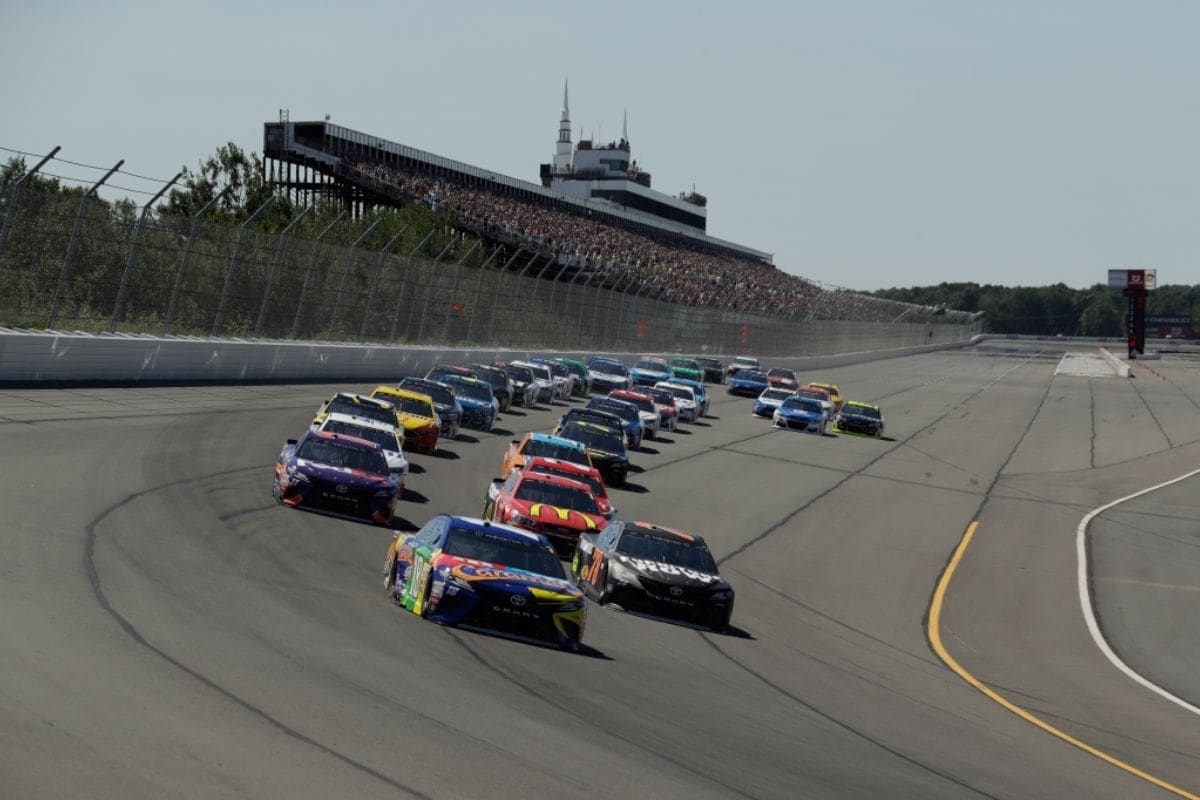Pocono Raceway is the Toughest Track: Pocono Raceway, often dubbed the ‘Tricky Triangle,’ poses unmatched challenges for drivers due to its distinctive tri-cornered design, each turn inspired by a different track. The complexities begin with Turn One, a high-speed entry demanding precision braking, followed by the notoriously tight and unforgiving Turn Two, or the ‘Tunnel Turn,’ that tests a driver’s nerve and control. Turn Three‘s long, sweeping curve requires impeccable throttle management. This multifaceted track configuration forces continuous adaptation, pushing drivers to their limits. Moreover, unpredictable weather and tactical pit stop decisions further amplify the difficulty.
Key Highlights
- Pocono’s unique three-turn layout with varying banking creates diverse technical challenges for drivers.
- Each turn at Pocono demands different skills: precise braking, sharp apex navigation, and throttle control.
- The ‘Tunnel Turn’ is a high-speed, flat-banked corner requiring exceptional precision and minimal error.
- Teams must balance car setups for high-speed stability and aerodynamic efficiency, adding strategic complexity.
- Pocono’s unpredictable weather conditions further complicate race strategies and driver adaptability.
Pocono Raceway: NASCAR’s Unorthodox Challenge
Pocono Raceway, often known as the ‘Challenging Triangle,’ highlights NASCAR’s most distinct challenges with its unique three-turn layout, each with varying degrees of banking that demand unparalleled driver skill and planning.
Unlike traditional oval tracks, Pocono’s uncommon triangular configuration requires exceptional adaptability from drivers and teams. Turn One, inspired by the old Trenton Speedway, features a 14-degree banking, requiring high-speed entry and precise braking.
Conversely, Turn Two, resembling the Indianapolis Motor Speedway, has an 8-degree banking, challenging drivers with a sharp, narrow apex and limited room for error. Turn Three, with a mere 6-degree banking, is modeled after the now-defunct Milwaukee Mile, testing drivers’ throttle control and exit speed onto the long front straight.
Each turn at Pocono Raceway presents a distinct set of challenges, creating a trio of technical obstacles that few other tracks can duplicate. Teams must fine-tune their cars to handle the high-speed demands of Turn One while ensuring stability and grip through the flat and sweeping Turn Three.
The adjustments necessary to optimize performance across these diverse turns often lead to strategic dilemmas, making engineering skills and driver feedback crucial. In addition, Pocono’s 2.5-mile length and unique layout mean that drafting and aerodynamic efficiency play critical roles, adding complexity to race strategy.
Insights from Noah Gragson on Pocono’s Challenges
Drawing from his extensive experience, Noah Gragson of Stewart-Haas Racing reveals that the intricate balance required to drive the Pocono Raceway‘s triad of turns presents a nearly insurmountable challenge for drivers and engineers.
Gragson highlights the unique difficulty posed by the track’s three distinct corners, each demanding a different approach and setup. The variability in banking angles—14 degrees in turn one, eight degrees in turn two, and six degrees in turn three—requires exceptional adaptability and precision from the driver.
Gragson elaborates that turn one, with its steep 14-degree banking, calls for a setup that enhances grip and stability, allowing drivers to maintain high speeds without sacrificing control. This setup, however, is at odds with the requirements for turn three, where the banking drops to a mere six degrees. Here, the focus shifts to ensuring ideal tire contact and minimizing understeer, a challenge that becomes more pronounced due to the flatness of the turn.
The difference between these turns forces engineers into a perpetual balancing act, often requiring compromises that can leave the car subpar in certain sections of the track. Gragson notes that while advances in technology and data analytics have improved the ability to predict and adjust for these variances.
It’s starting to feel real around here!
We are under 10 days away from @NASCAR Race Weekend!
What are you most excited for?#CRCBrakleen175 #ExplorePocono225 #PAGetaway400 #NASCAR pic.twitter.com/QHtFo73lnh
— Pocono Raceway (@PoconoRaceway) July 6, 2024
The Infamous ‘Tunnel Turn’
Traversing the ‘Tunnel Turn’ at Pocono Raceway highlights the distinct combination of intricate finesse and split-second decision-making needed to master this infamous section of the track. Known formally as Turn 2, the ‘Tunnel Turn’ is a high-speed, flat-banked corner that poses a formidable challenge even to the most seasoned drivers. The turn’s minimal banking offers little room for error, demanding precision in both entry and exit to maintain peak speed and track position.
“It’s just super flat as far as banking, and you’re pretty hammer down through there. It’s all timing. You might touch the brake, barely. You carry a lot of speed, and you have to be right with your steering input.” – (Gragson)
The complexity of the ‘Tunnel Turn’ is elevated by its tactical location on the track. With speeds reaching upwards of 180 mph, drivers must execute near-perfect timing and minimal braking to drive this turn effectively.
Any miscalculation can lead to significant loss of position or, worse, catastrophic accidents, particularly when racing in close quarters. This makes the ‘Tunnel Turn’ not only a test of skill but also of nerve and mental acuity.
Mastering Pocono: A Driver’s Perspective
Understanding the complexities of the ‘Tunnel Turn‘ is just one aspect of the broader expertise required to master the entire Pocono Raceway, as drivers like Gragson emphasize the critical role of synergy between man and machine in conquering this demanding circuit.
The three-turn configuration of Pocono, each with its own unique characteristics, demands a versatile skill set from drivers. Gragson’s insights reveal that mastering Pocono is not solely about technical skill but an intimate connection with the car’s dynamics.
“Just trying to get the car handling right all the way around the racetrack and feeling good about it is hard. All the corners are important, and you really have to be good in all of them, and if you get your car dialed in, you can get all three pretty good.” – (Gragson)
The initial key to success at Pocono is the ability to precisely feel and respond to the car’s behavior through each corner. Turn One, inspired by the Trenton Speedway, requires a delicate balance of speed and grip.
Drivers must gauge the exact moment to decelerate and then accelerate smoothly to maintain peak track position. The ‘Tunnel Turn’, echoing Indianapolis Motor Speedway, necessitates a brief yet crucial adjustment, where the car’s stability and the driver’s reflexes are put to the test.
Gragson also highlights the importance of consistent race craft. At Turn Three, a nod to the Milwaukee Mile, drivers face a long, flat corner that tests tire management and exit speed. Here, maintaining momentum while preserving tire integrity is paramount.
Anticipation for Sunday’s Race at Pocono
The anticipation surrounding Sunday’s race at Pocono Raceway is noticeable, as fans and insiders all enthusiastically speculate on which driver will master the track’s intricate challenges and clinch victory. This season, the stakes are higher than ever, with the unique demands of the track promising a thrilling contest that tests every aspect of a driver’s skill and strategy.
Pocono Raceway’s location in the Pocono Mountains means weather can be a wild card. Sudden changes in conditions can drastically affect grip levels and visibility, adding complexity to race strategies.
Pit stops and tire management will be vital. The long straights and tough corners put immense stress on tires, making the timing and execution of pit stops a critical factor in maintaining competitive lap times.

News in Brief: Pocono Raceway is the Toughest Track
Pocono Raceway, with its tri-cornered layout and distinctive practical challenges in each curve, highlights the ultimate trial of a driver’s expertise and flexibility. The high-velocity requirements of Curve One, the accuracy needed in Curve Two, and the throttle management in Curve Three, along with the infamous ‘Tunnel Turn,’ establish intricacy.
Unforeseeable weather conditions and well-planned pit stops additionally enhance the challenge, confirming Pocono’s renown as the most demanding track on the circuit.
ALSO READ: Pocono Raceway Legacy: From Challenges to Safety Evolution in NASCAR


